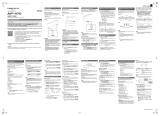
13
Introduction
a POWER button
This switch is used to turn the instrument on/o . Be sure to turn o the
instrument after playing.
* The AnyTimeX2 piano features a power saving mode that can turn o the
instrument automatically after a speci ed period of inactivity. For more
information, please refer to the ‘Auto Power O ’ setting on page 108.
b VOLUME knob
This knob is used to adjust the volume when AnyTime mode is activated.
Turn the knob clockwise to increase the volume.
c PHONES jacks
These jacks are used to connect stereo headphones to the AnyTimeX2 piano.
Two pairs of headphones can be connected and used simultaneously.
d USB to DEVICE port
This port is used to connect a FAT or FAT32 formatted USB memory
device to the instrument in order to load/save recorded song data and
MP3/WAV/SMF les etc.
e Headphone Hook
This hook is used to conveniently hang the headphones when not in use.
* The headphone hook is not pre-attached for grand pianos. Attach the
included headphone hook with the two screws provided, as shown in the
illustration on the previous page.
f LCD display
The LCD display provides useful information such as the currently
selected sound name, settings values, and the status of other functions
when active.
* A protective plastic lm is attached to the display during production.
Please remove this lm before attempting to play the instrument.
g FUNCTION button
These buttons are used to select one of three functions/options shown
at the bottom of the LCD display.
DUAL MENUSPLIT
h ARROW buttons
These buttons are used to navigate around the various menus and
screens, adjust values, and answer on-screen prompts.
i EFFECTS button
This button is used to turn e ects for the selected sound on/o , to
select the di erent e ect types, and to adjust their settings.
j REVERB button
This button is used to turn reverb for the selected sound on/o , to
select the di erent reverb types, and to adjust their settings.
k METRONOME button
This button is used to turn the metronome function on/o , and also to
adjust the tempo, time signature (or beat), and volume settings.
l PLAY/STOP button
This button is used to start/stop the playback of demonstration songs,
Piano Music pieces, and Lesson and Finger Exercises, and to start/stop
the recording and playback of recorder songs, and MP3/WAV audio les.
m REC button
This button is used to record performances to internal memory or a USB
memory device as MP3/WAV audio les.
n SOUND buttons
These buttons are used to select the sound(s) that will be heard when playing
the keyboard in AnyTime mode. Multiple sounds are assigned to each category
button, and can be selected by pressing the same button repeatedly.
o MUSIC button
This button is used to select AnyTimeX2 piano’s built-in Demonstration
songs, Piano Music pieces and Lesson songs.
p LINE IN jack
This jack is used to connect the stereo output from audio equipment,
computers, or other electronic instruments to the AnyTimeX2 piano.
q LINE OUT jack
This jack is used to connect the stereo output of the AnyTimeX2 piano to
external ampli ers, mixers, recording devices, and similar equipment.
r MIDI IN / OUT jacks
These jacks are used to connect the AnyTimeX2 piano to external MIDI
devices such as other musical instruments or a computer in order to
send and receive MIDI data.
* For more information about the instrument’s connectors and jacks, please
refer to ‘Connecting to Other Devices’ on page 109.
s DC IN Jack
This jack is used to connect the AC adaptor.
t Mute Pedal (upright piano)
This pedal is used to mute the acoustic piano sound. Depress this pedal
and slide it gently to the left to activate AnyTime mode.
Do not attempt to activate/deactivate AnyTime mode while playing the piano
as this can cause serious damage to the action mechanism of the instrument.
u Damper Pedal
This pedal is used to remove all dampers from the strings, allowing
them to vibrate freely. This greatly enriches the piano’s sound, while
also assisting the pianist to play smooth ‘legato’ passages.
v Soft Pedal / Sostenuto Pedal (upright piano)
This pedal is used to soften the sound, reducing its volume.
When ‘Jazz Organ’ or ‘Drawbar Organ’ sounds are selected, the soft
pedal is used to alternate the speed of the rotary speaker simulation
between ‘Slow’ and ‘Fast’ e ect modes.
With upright AnyTimeX2 instruments, it is also possible to use the Soft
pedal as a Sostenuto pedal by depressing the pedal while turning on
the AnyTimeX2 piano control panel.
w Sostenuto Pedal (grand piano)
This pedal is used to sustain one group of notes while other notes are
played without sustain.
x Muting Lever (grand piano)
This lever is used to mute the acoustic piano sound. Pull the lever gently to
the left to activate AnyTime mode. Do not attempt to activate/deactivate
AnyTime mode while playing the instrument as this can cause serious
damage to the action mechanism of the instrument.
y Mu er lever (upright piano)
This lever is used to activate/deactivate the mu er system of the
acoustic piano.
Pull the lever to activate and push it back to deactivate.




















